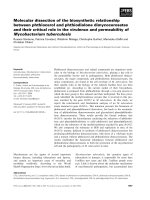Mapping of the binding surface between EPHA5 and antagonist peptide by NMR spectroscopy
Bạn đang xem bản rút gọn của tài liệu. Xem và tải ngay bản đầy đủ của tài liệu tại đây (4.78 MB, 96 trang )
MAPPING OF THE BINDING SURFACE BETWEEN
EPHA5 AND ANTAGONIST PEPTIDE BY NMR
SPECTROSCOPY
ZHU WAN LONG
NATIONAL UNIVERSITY OF SINGAPORE
2009
MAPPING OF THE BINDING SURFACE BETWEEN
EPHA5 AND ANTAGONIST PEPTIDE BY NMR
SPECTROSCOPY
ZHU WAN LONG
A THESIS SUBMITTED FOR THE DEGREE OF
MASTER OF SCIENCE
DEPARTMENT OF BIOLOGICAL SCIENCES
NATIONAL UNIVERSITY OF SINGAPORE
2009
ACKNOWLEDGEMENTS
I would very much like to express my sincere appreciation to my supervisor,
Associate Professor Song Jianxing for his support and experimental guidance thorough
the duration of this study.
I would like to give my special thanks to Ms. Qin Haina for her help in
determining the structure of WDC by NMR, and to Dr. Shi Jiahai for his work in
determining the structure of EphA5 by X-ray crystallography.
I also want to thank Dr. Liu Jingxian, Ms. Huan Xuelu as well as all my lab mates
for their valuable advices and help in this project. In addition, I am thankful to Dr. Fan
Jingsong for all the NMR trainings and his kind assistance in NMR experiments.
Especially, I would like to thank my parents for their strong and continuous
support and encouragement for my study.
Finally, I am grateful to the Ministry of Education of Singapore for the scholarship
support and National University of Singapore for the excellent post-graduate programme
and research environment.
I
Table of Contents
ACKNOWLEDGEMENTS...............................................................................................I
TABLE OF CONTENTS..................................................................................................II
SUMMARY......................................................................................................................VI
LIST OF FIGURES......................................................................................................VIII
LIST OF TABLES............................................................................................................X
LIST OF ABBREVIATIONS.........................................................................................XI
APPENDIX....................................................................................................................XIII
Chapter I INTRODUCTION...........................................................................................1
1.1 Introduction to Eph Receptors. ..............................................................................1
1.1.1 Biological background of Eph receptors.......................................................1
1.1.2 Structures of Eph receptors and the Eph receptor/ephrin complexes…...3
1.1.3 Drug designs from structural insights of Eph receptors and ephrin
ligands.................................................................................................9
1.1.4 Function of EphA5 receptor.........................................................................10
1.2 Structure Determination of Protein/Peptide.......................................................11
1.2.1 Introduction to NMR spectroscopy.............................................................12
1.2.1.1 NMR....................................................................................................12
1.2.1.2 NMR parameters................................................................................12
1.2.1.2.1 Chemical shift.........................................................................12
1.2.1.2.2 J coupling.................................................................................13
1.2.1.2.3 NOE..........................................................................................14
1.2.2 Introduction to X-ray crystallography........................................................14
II
1.2.2.1 X-ray crystallography........................................................................14
1.2.2.2 Solution to phase problem.................................................................15
1.2.2.2.1 Direct methods..........................................................................15
1.2.2.2.2 Multiple isomorphous replacement (MIR)............................16
1.2.2.2.3 Anomalous scattering...............................................................16
1.2.2.2.4 Molecular replacement (MR) .................................................17
1.2.2.3 Refinement of initial model...............................................................17
1.3 Research Aims.........................................................................................................18
Chapter II MATERIALS AND METHODS.................................................................19
2.1 Cloning of Proteins and/or Peptides.....................................................................19
2.2 Selection of Residues for Sit-directed Mutagenesis............................................20
2.3 Transformation of E. coli Cells.............................................................................20
2.4 Expression and Purification of EphA5 and Peptides...................................20
2.4.1 Expression and purification of the EphA5 ligand-binding domain...........20
2.4.2 Expression and purification of WDC and its mutants................................23
2.4.3 Preparation of isotope-labelled protein and/or peptides.............................23
2.5 Circular Dichroism (CD) Measurement ............................................................23
2.6 Crystallization of EphA5......................................................................................24
2.7 Characterization of the Binding of EphA5 with WDC and its Mutants by
HSQC of NMR.....................................................................................................24
2.8 Characterization of the Binding of EphA5 with WDC and its Mutants by
Isothermal Titration Calorimetry (ITC) ...........................................................25
2.9 NMR Experiments of EphA5 and WDC.............................................................25
III
2.9.1 Backbone assignment of EphA5...................................................................25
2.9.2 Structure determination of WDC by NMR.................................................26
Chapter III EXPERIMENTAL RESULTS AND DISCUSSIONS............................27
3.1 Expression of EphA5 Ligand-Binding Domain.................................................27
3.2 Structural Characterization of EphA5 by CD...................................................27
3.3 Crystal Structure of EphA5 Ligand-Binding Domain......................................29
3.4 Structural Characterization of EphA5 by NMR...............................................29
3.5 Characterization of Binding Interactions between EphA5 and WDC Peptide
by NMR.................................................................................................................32
3.6 Characterization of Binding Interactions between EphA5 and WDC Peptide
by ITC...................................................................................................................35
3.7 Structural Characterization of WDC by CD......................................................38
3.8 Structural Characterization of WDC by NMR..................................................38
3.9 NMR Structure of WDC......................................................................................42
3.10 Mapping of Binding Interface between EphA5 and WDC by NMR.............46
3.10.1 Mapping of EphA5-binding interface within WDC by NMR and ITC..46
3.10.1.1 Interaction of WDC-mutant peptides with EphA5 by NMR……...46
3.10.1.2 Interaction of WDC-mutant peptides with EphA5 by ITC……….50
3.10.1.3 Structural comparison of WDC and its mutant peptides by CD…50
3.10.2 Mapping of EphA5-binding interface to WDC by NMR........................54
3.10.2.1 Backbone sequential assignment of EphA5 without and with
WDC..................................................................................................54
IV
3.10.2.2 Mapping of EphA5-binding interface to WDC by chemical shift
perturbation analysis.........................................................................58
Chapter IV CONCLUSION AND FUTURE WORK.................................................61
Chapter V REFERENCES.............................................................................................62
APPENDIX.....................................................................................................................71
V
SUMMARY
The Eph receptors constitute the largest family of receptor tyrosine kinases, with
16 individual receptors that are activated by 9 different ephrins throughout the animal
kingdom. Eph receptors and their ligands are both anchored to the plasma membrane,
and are subdivided into two subclasses (A and B) based on their sequence conservation
and binding preferences. The critical roles of Eph-ephrin mediated signalling in various
physiological and pathological processes mean that the interface at which the interaction
between receptor and ligand occurs is a promising target for the development of
molecules to treat human diseases, such as neuron regeneration, bone remodelling
diseases, and cancer.
A diverse spectrum of peptides that act as antagonists of Eph-ephrin with
differential selectivity has previously been identified. One of these peptides, called WDC,
is attractive because it has been found to antagonize the interaction between EphA5 and
its ligands with high selectivity. EphA5 receptor and its ligands serve as repulsive
axonguidance cues in the developing brain. Their interaction triggers growth cone
collapse and inhibits the neurite outgrowth in vitro. Furthermore, abnormal expression of
these molecules would result in the disruption of axonal path finding and mid-line
crossing in vivo. So far, the three-dimensional structure of the EphA5 ligand-binding
domain has not been determined.
In the present study, the crystal of EphA5 ligand-binding domain was obtained.
Structural characterizations of both EphA5 and WDC were assessed by CD and NMR.
VI
Furthermore, characterizations of binding interactions between EphA5 and WDC peptide
were characterized by NMR and ITC. The binding surface between EphA5 and WDC
was demonstrated using NMR.
Interestingly, WDC was found to be well-folded even in the free-state. Its binding
surface for EphA5 receptor was mapped by Ala site-directed mutagenesis and NMR
titration. Taken all together, our results may provide critical rationales for further design
of specific EphA5 antagonists for various therapeutic applications.
VII
LIST OF FIGURES
Figure 1
Domain structure and binding interfaces of Eph receptors and ephrins.............2
Figure 2
Structural comparisons of EphA4 and other Eph ligand-binding domains........5
Figure 3 Ephrin binding domain of EphB4 receptor in complex with the ephrinB2
extracellular domain...........................................................................................6
Figure 4 Ephrin binding domain of EphA2 receptor in complex with the ephrinA1
extracellular domain...........................................................................................8
Figure 5
Samples of EphA5 receptor on a 15% SDS-PAGE gel....................................24
Figure 6 Preliminary structural characterization of EphA5 by CD.................................30
Figure 7
Crystal structure of the EphA5 ligand-binding domain...................................31
Figure 8
1
Figure 9
NMR characterization of the binding between EphA5 and WDC...................34
H-15N HSQC spectrum of the EphA5 ligand-binding domain........................33
Figure 10 ITC characterization of the binding between EphA5 and WDC.....................36
Figure 11 Comparison of retention time between native and denatured WDC on an
analytic RP-18 column....................................................................................39
Figure 12 MALDI-TOF mass spectrum of WDC............................................................40
Figure 13 Preliminary structural characterization of WDC by CD.................................41
Figure 14 NMR characterization of WDC.......................................................................43
Figure 15
Structures of WDC in the ribbon mode as determined by NMR...................45
Figure 16 Characterization of the binding between 15N-labeled EphA5 and WDC mutant
peptides as determined by NMR.....................................................................48
Figure 17 Characterization of the binding between EphA5 and WDC mutant peptides as
VIII
determined by ITC..........................................................................................51
Figure 18 NMR structures of WDC in the ribbon mode with labelled side chains.........52
Figure 19 Preliminary structural characterization of WDC and its mutants by CD…....53
Figure 20
Assigned 1H-15N HSQC spectrum of the EphA5 ligand-binding domain......55
Figure 21
Assigned 1H-15N HSQC spectrum of the EphA5 ligand-binding domain in the
presence of 3-fold WDC.................................................................................56
Figure 22 Secondary structures of EphA5 as calculated by ΔCα and ΔCβ.....................57
Figure 23 Residue-specific CSD of the EphA5 ligand-binding domain in the presence of
3-fold WDC.....................................................................................................60
IX
LIST OF TABLES
Table 1 Mutants of WDC peptide and their corresponding oligo nucleotides................21
Table 2 Thermodynamic parameters of the binding interactions of the EphA5 receptor
with WDC and its two mutants........................................................................37
Table 3 Chemical shift of WDC in 10 mM phosphate buffer (pH 6.3) at 15˚C..............44
X
LIST OF ABBREVIATIONS
1D/2D/3D
One-/Two-/Three-dimensional
a.a.
Amino acid
cDNA
Complementary DNA
CD
Circular Dichroism
CS
Chemical Shift
Da (kDa)
Dalton (kilodalton)
DNA
Deoxyribonucleic Acid
DTT
Dithiothreitol
E. coli
Escherichia coli
EDTA
Ethylenediaminetetraacetic Acid
Eph
Erythropoietin Producing Hepatocellular Receptor
FID
Free Induction Decay
FPLC
Fast Protein Liquid Chromatography
g/mg/μg
Gram/Milligram/Microgram
GndHCl
Guanidine Hydrochloride
GST
Gluthathione S-transferase
HSQC
Heteronuclear Single Quantum Coherence
IPTG
Isopropyl-β-D-thiogalactopyranoside
l/ml/μl
Liter/Milliter/Microliter
LB
Luria Bertani
XI
MALDI-TOF MS
Matrix-Assisted Laser Desorption/Ionization Time-of-flight
Mass Spectroscopy
min
Minute
M (mM)
Mole/L (Milimole/L)
MR
Molecular Replacement
MW
Molecular Weight
NMR
Nuclear Magnetic Resonance
NOE
Nuclear Overhauser Effect
NOESY
Nuclear Overhauser Effect Spectroscopy
OD
Optical Density
PBS
Phosphate-buffered Saline
PCR
Polymerase Chain Reaction
PDB
Protein Data Bank
ppm
Parts Per Million
RMSD
Root Mean Square Deviation
RP-HPLC
Reversed-Phase High Performance Liquid Chromatography
SDS-PAGE
Sodium Dodecyl Sulfate Polyacrylamide Gel Eletrophoresis
TOCSY
Total Correlation Spectroscopy
Tris
2-amino-2-hydroxymethyl-1,3-propanediol
UV
Ultraviolet
βME
β-Mercaptoethanol
XII
APPENDIX
Figure 1 Sequence alignment of the ligand binding domains of EphA5 with EphA2 and
EphB2.................................................................................................................71
Table 1
15
N, 15NH and 13C chemical shift of EphA5 at pH 6.3 and 25°C.....................72
Table 2
15
N, 15NH and 13C chemical shift of EphA5 in the presence of 3-fold WDC at
pH 6.3 and 25°C................................................................................................77
XIII
Chapter I INTRODUCTION
1.1
Introduction to Eph Receptors
1.1.1 Biological background of Eph receptors
The erythropoietin-producing hepatocellular carcinoma (Eph) family is the largest
family of receptor tyrosine kinases identified to date, with 16 structurally similar family
members (Eph Nomenclature Committee, 1997). Eph is divided into two subclasses, A
and B, based on binding preferences and sequence conservation. In general, EphA
receptors (EphA1–EphA10) bind to glycosyl phosphatidyl inositol (GPI)-anchored
ephrinA ligands (ephrinA1–ephrinA6), whereas EphB receptors (EphB1–EphB6) interact
with transmembrane ephrinB ligands (ephrinB1–ephrinB3). Although the interactions
between Eph receptors and eprhins in the same subclass are quite promiscuous, the
interactions between subclasses are relatively rare (Pasquale, 2008; Gale et al. 1996; Qin
et al. 2008).
As shown in Figure 1, Eph receptors have a modular structure that consists of an
N-terminal ephrin binding domain adjacent to a cysteine-rich domain and two fibronectin
type III repeats in the extracellular region. The intracellular region consists of a
juxtamembrane domain, a conserved tyrosine kinase domain, a C-terminal sterile adomain, and a PDZ binding motif. The N-terminal 180 amino acid globular domain is
sufficient for high-affinity ligand binding. The adjacent cysteine-rich region might be
involved in receptor–receptor oligomerization often observed on ligand binding (Qin et al.
2008; Pasquale 2005).
1
Figure 1: Domain structure and binding interfaces of Eph receptors and ephrins.
(Pasquale, 2005)
2
The communication of biochemical signals between cells is essential for the
development and existence of multicellular organisms. The direct protein-protein
interactions between ligands carrying the signal, and cell-surface receptors recognizing
and transforming the information into the receiving cell are the key method of
communication (Himanen et al. 2001). Being one of the large groups of receptors and
ligands, the Eph/ephrin family sends information bidirectionally into both the receptorexpressing cell and the ligand-expressing cell (Pasquale 2005; Flanagan et al. 1998;
Himanen et al. 2003; Kullander et al. 2002). Upon ephrin binding, the tyrosine kinase
domain of the Eph receptors is activated and therefore, initiating ‘forward’ signalling in
the receptor-expressing cells. At the same time, signals are also induced in the ligandexpressing cells, a phenomenon referred to as ‘reverse’ signalling (Holland et al. 1996;
Himanen et al. 2007).
The Eph/ephrin family plays important roles in both developing and adult tissues,
and regulates biological processes such as tissue patterning, development of the vascular
system, axonal guidance, and neuronal development (Pasquale, 2005; Pasquale, 2008;
Brantley-Sieders et al. 2004). It also has been shown to function in bone remodelling,
immunity, blood clotting, and stem cells. Recently, the Eph-ephrinB-mediated signalling
network has been implicated in learning and memory formation, neuronal regeneration,
pain processing, and differential expressions of ephrinB are also correlated with
tumorigenesis (Battaglia et al. 2003; Ran et al. 2005).
1.1.2 Structures of Eph receptors and Eph receptor/ephrin complexes
Because the Eph receptors/ephrins play very important roles in various biological
3
progresses, the structural study of these Eph/ephrins will help us to understand the
detailed mechanism of the binding and recognition between Eph receptors and ephrin
ligands. The structures of the ligand-binding domains of EphA2, EphA4, EphB2 and
EphB4 have been determined in the Free State and in complex with ephrins or peptide
antagonists by X-ray crystallography (Qin et al. 2008; Himanen et al. 2001; Himanen et
al. 2004; Chrencik et al. 2006; Chrencik et al. 2006; Chrencik et al. 2007; Himanen et al.
2009). These studies have shown that all the Eph ligand-binding domains adopt the same
jellyroll β-sandwich architecture that are composed of 11 antiparallel β-strands connected
by loops of various lengths, although they belong to different subclass of Eph receptors
(Figure 2). Although the H-I loop has no regular secondary structure in all the examined
EphB receptor structures, the EphA2 and EphA4 receptors form a 310-helix in the H-I
loop.
The crystal structures of Eph ligand-binding domains and ephrin indicate that
initial high affinity binding of Eph receptors to ephrin occurs through the penetration of
an extended G–H loop of the ligand into a hydrophobic channel on the surface of the
receptor. In particular, the D-E and J-K loops have been revealed to play a critical role by
forming the high affinity Eph-ephrin binding channel (Himanen et al. 2009).
The structure of the EphB2-ephrinB4 complex showed that the ligand-binding
channel of the receptor is located at the upper convex surface of EphB2, and is formed by
the flexible J-K, G-H, and D-E loops, which become ordered to accommodate the
solvent-exposed ephrin G-H loop (Figure 3). A low affinity tetramerization interface,
which interacts with the C-D loop of the ephrin has also been identified at the concave
surface of the receptor H-I loop (Chrencik et al. 2006).
4
Figure 2: Structural comparisons of EphA4 and other Eph ligand-binding domains.
(a) Superimposition of the ligand-binding domains of EphA4 Structure A (violet) and
EphA2 (3C8X; blue). (b) Stereo view of the superimposition of two EphA4 structures
(structure A in red and structure B in lime green) with previously determined EphB2 and
EphB4 structures (all in purple). (Qin et al. 2008)
5
Figure 3: Ephrin binding domain of EphB4 receptor in complex with the ephrinB2
extracellular domain. EphB4 receptor (red) consists of a jellyroll folding topology with
13 anti-parallel B-sheets connected by loops of varying lengths, whereas the ephrin
ligand (blue) is similar to the Greek key folding topology. The interface is formed by
insertion of the ligand G-H loop into the hydrophobic binding cleft of EphB4. (Chrencik
et al. 2006)
6
The EphA2/ephrinA1 heterodimer is architecturally similar to the EphB2ephrinB4 complexes (Figure 3). The ligand/receptor interface centers around the G–H
loop of ephrinA1, which is inserted in a channel on the surface of EphA2 (Figures 4).
Eph receptor strands D, E and J, define the two sides of the channel, whereas strands G
and M line its back. The ligand binds by approximating the side of its β-sandwich to the
outside surface of the channel and then inserting its long G–H loop into the channel,
which finally becomes buttressed by the G–H loop of the receptor closing in from the top.
The binding is dominated by the Van der Waals contact between two predominantly
hydrophobic surfaces. Adjacent to the channel/G–H-loop interactions, a second,
structurally separate, contact area encompasses the ephrinA1 docking site along the upper
surface of the receptor. Here, the ephrin β-sandwich (strands C, G and F) interacts
through a network of hydrogen bonds and salt bridges with EphA2 strands D, E and the
B–C loop region (Himanen et al. 2009).
Comparison of the EphA2/ephrinA1 structure with the EphB2/ephrinB4
complexes yields insight into the molecular basis for the observed Eph receptor/ephrin
subclass specificity (Figures 3, 4). Eph receptor subclass specificity is probably
maintained in part by the fact that the differences in the structures of the A- and B-class
molecules result in different architectural arrangements of ligands and receptors in the Aand B-subclass complexes. Figures 3 and 4 illustrate that the B-class complexes adopt a
more ‘compact’ conformation with intimate interactions between the Eph receptor B–C
region and the juxtaposing C, F and G ephrin strands, whereas the A-class complex is
more ‘open’ with a smaller number of interactions in the above-mentioned region, but
with a more intimate interaction network between the ephrin G-H loop and the D–E, J–K
7
Figure 4: Ephrin binding domain of the EphA2 receptor in complex with the
ephrinA1 extracellular domain EphA2. EphA2 (Blue): residues Glu28–Cys201 and
ephrin-A1 (Red): residues Ala18–Ile151. (Himanen et al. 2009)
8
and G–H loops of Eph receptor (Himanen et al. 2009).
The different complex structures suggest that the interactions between receptor
and ligand in the A-class Eph receptor/ephrin involve smaller rearrangements in the
interacting partners, better described by a ’lock-and-key’-type binding mechanism, in
contrast to the ’induced fit’ mechanism defining the B-class molecules (Himanen et al.
2009).
1.1.3 Drug designs from the structural insights of Eph receptors and ephrin ligands
As the Eph receptors constitute the largest RTK family, imbalance of Eph/ephrin
function may therefore contribute to a variety of diseases, such as diabetes, tumor, spinal
cord injury, abnormal blood clotting and bone remodeling diseases. The critical roles of
Eph receptors in various physiological and pathological processes have validated the Eph
receptor as the promising targets for the development of anti-tumor and neuronal
regeneration drugs (Tang et al. 2007; Fry et al. 2005; Klein 2004; Yamaguchi et al. 2004;
Goldshmit et al. 2004; Fabes et al. 2006; Fabes et al. 2007).
According to the structural information for Eph receptors and ephrin ligands, the
majority of the Eph receptor/ephrin interactions involve the extended G–H ephrin loop
interacting with the Eph receptor surface channel. It has been proposed that some small
peptides and chemical compounds could bind to the Eph receptor channel and block Eph
receptor signaling by preventing ephrin binding to Eph receptor (Qin et al. 2008; Koolpe
et al. 2002; Chrencik et al. 2006; Chrencik et al. 2007; Koolpe et al. 2002).
Despite the presence of several binding interfaces, peptides that target the high
affinity site are sufficient to inhibit Eph receptor-ephrin binding. Interestingly, unlike the
9
ephrins, which bind in a highly promiscuous manner, a number of the peptides that were
identified by phage display selectively bind to only one or a few of the Eph receptors
(Koolpe et al. 2005; Chrencik et al. 2007). The antibodies and soluble forms of Eph
receptors and ephrins extracellular domains that modulate Eph-ephrin interactions have
also been identified (Pasquale, 2005; Ireton et al. 2005; Noren et al. 2007; WimmerKleikamp et al. 2005). Several small inhibitors of the Eph receptor kinase domain have
also been reported. These inhibitors occupy the ATP-binding pocket of the receptors and
are usually broad specificity inhibitors that target different families of tyrosine kinases
(Caligiuri et al. 2006; Karaman et al. 2008).
Recently, two small molecules (2,5-dimethylpyrrolyl benzoic acid derivative and
its isomeric compound) have been identified by a high throughput screening, which are
able to antagonize ephrin-induced effects in EphA4-expressing cells. The antagonizing
benzoic acid derivatives occupy a cavity in the ephrin-binding EphA channel by
interacting with residues Ile31–Met32 in the D–E loop, Gln43 in the E strand, and Ile131–
Gly132 in the J–K loop (Noberini et al. 2008; Qin et al. 2008).
1.1.4 Functions of EphA5 receptor
EphA5 receptor is a member of the Eph receptor tyrosine kinase family. It is
thought to be wildly expressed in most tissues, and higher expression mainly occurs in
the hippocampus, striatum, hypothalamus, and amygdale in the adult brain (Gerlai et al.
1999).
The function of the EphA5 receptor is best characterized as an axon guidance
molecule during neural development. EphA5 receptor and its ligands act as a repellent
10









